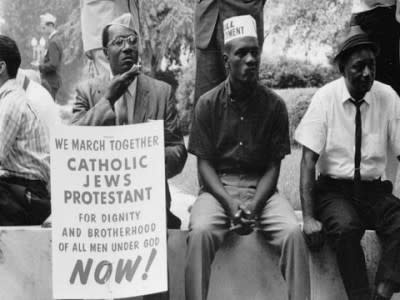Selma: The Shining Moment In The Conscience Of Man
On March 7, 1965, civil rights activists were attacked by Alabama police fought near a bridge in Selma, Alabama, in a moment that shocked a nation and helped lead to the Voting Rights Act. Today, the images are still shocking and the debate over voting rights remains unsettled.
Bloody Sunday led to more marches
A crowd of about 525 people gathered near the Edmund Pettus Bridge to start a 45-mile march to Montgomery, Alabama, to raise awareness about the killing of Jimmie Lee Jackson. Jackson was shot three weeks earlier by an Alabama state trooper as he was protecting his mother during voter registration march.
The group led by Hosea Williams and John Lewis walked over the Pettus Bridge and it was then attacked, in front of journalists and photographers, by Alabama state police and a posse that had been formed for the occasion that was acting under the orders of Alabama Governor George Wallace. The police gave the group two minutes to leave the scene; the protesters opted to pray.
Newspapers at the time were graphic in their description of the one-sided confrontation. National television networks also had extended coverage of the scene, where marchers were beaten as they prayed and then gassed by police and the posse, as white onlookers cheered.
Absent from the first march was Dr. Martin Luther King Jr., who was at his Atlanta church on what became known as “Bloody Sunday.” King quickly told reporters that he was heading to Selma to lead a second march on Tuesday. King also said he would seek restraining orders against Wallace and state police in federal court.
One image that resonated nationally was the picture of an injured marcher, Amelia Boynton. The local political and civil rights leader was beaten and gassed by police on the Pettus Bridge and she was carried off the bridge in front of the media gathered at the scene.
The second march at Selma on March 9 was short and ceremonial, as civil rights leaders waited for legal support. Dr. King led marchers over the Pettus Bridge and back to a church were the march began. But tragically, segregationists attacked three white ministers who took part in the march as they were eating dinner later that night, killing the Rev. James Reeb.
On March 17, federal judge Frank Johnson ruled that the demonstrators had a First Amendment right to march, saying that, “The law is clear that the right to petition one’s government for the redress of grievances may be exercised in large groups . . . . These rights may . . . be exercised by marching, even along public highways.”
Two days earlier, President Lyndon Johnson presented a draft of the Voting Rights Act to Congress. President Johnson had hoped that Governor Wallace would use the National Guard in Alabama to protect an upcoming third march, but Wallace refused, saying the state couldn’t afford the expense of supplying the troops.
For the third march, President Johnson sent 3,000 federal troops to Selma and he federalized the National Guard there. A group of 8,000 people set off from Selma and four days later, their numbers swelled to 25,000 when they arrived in Montgomery.
Wallace refused to accept a petition from the marchers and then Dr. King spoke to the large crowd.
“Selma, Alabama, has become a shining moment in the conscience of man. If the worst in American life lurked in the dark streets, the best of American instincts arose passionately from across the nation to overcome it,” King said. “The confrontation of good and evil compressed in the tiny community of Selma, generated the massive power that turned the whole nation to a new course.”
In August 1965, President Johnson signed the Voting Rights Act into law. Special invited guests at the event were Amelia Boynton and Dr. King.


